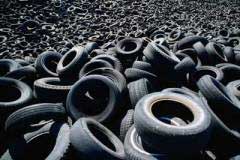How to Prevent Flat Tires - Vol.110
Tires happen to be the most important part of a car. As a matter of fact, a car is not really a car without its tires. As they are the only part of the car that remains in contact with the road, their role is more crucial than most of us reckon. That is why keeping an eye on their condition and performance is extremely important and must be considered a part of your car maintenance routine.
Any negligence in this aspect may prove to be dangerous and in many cases fatal. Incidentally, flat tires and blowouts in the middle of the road are known to be one of the biggest causes of accidents. So, what would you blame it on? Fate or human error!

While a number of flat tire and blowout incidents are inevitable, most of them are easily avoidable with proper measures and maintenance. So, for your safety and convenience, here are a few tips to include in your weekly maintenance schedule.
Keep them Well-Inflated
Always keep a check on your car's tire pressure. It should neither be too over nor under inflated. In both cases, the tires won't be able to put up with all the heat and friction and will eventually blowout mid way. Also, if the tire is over inflated, it becomes way too sensitive to the damage caused by bumps and holes on the road.
Another thing that could get burst due to under or over inflated tires is your wallet. Rightly said, inappropriate tire pressure can mingle with your fuel economy figures, and not in a way you would like. So, what you are required to do is to check the air pressure at least once a month and see if it matches the recommended rating given by the manufacturer.
Read the Treads
The treads on your tire may seem like an ordinary thing but that is the secret language your tires use to convey their messages, more like pleas to you. In other words, treads give you an idea of your tire's condition. If they seem worn out, your car needs a tire change.
One important thing to remember here is that the wearing out of treads is not always due to the miles you have run on the road. In fact, the rubber used in manufacturing the tire degenerates with time even if the tire stays in the warehouse forever.
Almost every tire has a wear mark, which indicates that your tire becomes useless if the treads are below past that mark. If the treads have uneven wear patterns that may be due to alignment issues. So, better get that checked as well.
Balance and Alignment
If your tires are not properly balanced or aligned, the pressure will increase on one or two of the tires. Due to extra pressure, these tires will wear out earlier maximizing the chance of blowouts. Also, faulty alignment will create handling issues which in turn may result in mishaps.
Make sure, you get your wheel alignment checked almost every month. It is best to get professional help in this aspect. For DIY inspection, take a look at the treads for uneven wear patterns.
Rotate Tires Regularly
The weight of your car is distributed in a way that the front wheels bear more stress than the rear wheels. Due to this reason, the front ones tend to wear out earlier than the rear ones. Automotive experts and tire manufacturers recommend that you must rotate your tires every 8,000 kms. This procedure will help increase the life of your tires.
If you find it hard to rotate them every 8,000 kms, you can schedule to do so with every oil change routine.
Keep it Light
With everything you load on your car, the weight is distributed among the tires. What most people do not know is the fact that every tire can endure weight up to a certain extent. If you are overloading your car with more weight than your tires can bear, you are sending an invitation to flat tires.
Make sure you read the manufacturer's manual to find out about the weight limit of your tires. It will save you a lot of trips to the mechanic.
Finally, keep an eye on the road and avoid sharp objects, potholes and bumps as much as possible. Include all of the above tips in your maintenance schedule and flat tires will remain a myth for your tires.